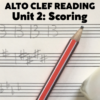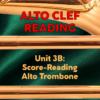When choosing a cue, select material from a player in close proximity to where your musician is seated. Of course, the cue should be composed of a thematic gesture first of all, and if there isn’t a good snatch of melody, then an obvious bit of chord or high note.
The following example is excerpted from the bass clarinet part of my recently completed harp concerto. In both cues, there are lines from strings or winds, or even the soloist, that happen right before the entrances. In cases like these, you have to realize that the player might not hear the soloist clearly from where they are sitting (especially in a harp concerto), and the strings may be interacting with other sections in a way that’s hard to follow. The music from players in their own section, however, will be unmistakable – particularly from one desk away. So when the clarinet is doubling the violins, make sure that the bass clarinetist’s cue mentions the clarinet. And when lines are in counterpoint, pick the line from a player of the same section (unless it’s buried in the texture). But of course, always pick the most obvious thing happening from any instrument group anywhere as your first rule in assigning cues, no matter where they are sitting in relation to the musician playing the part.











One response to “Parts – Ideal Cue Material”